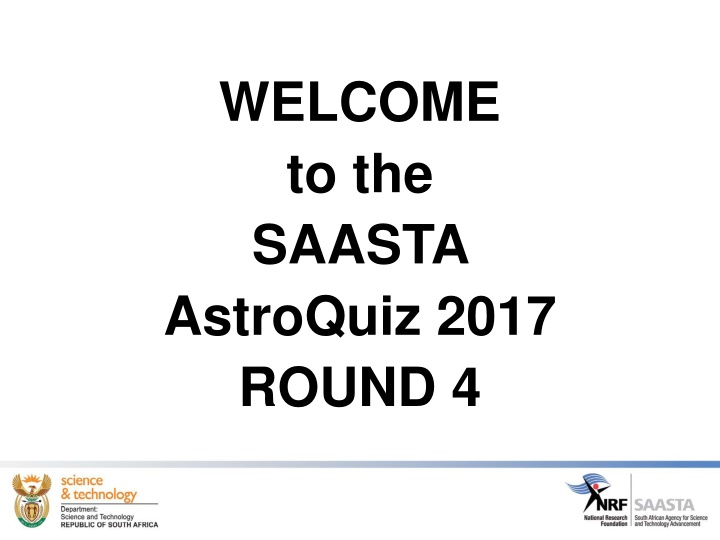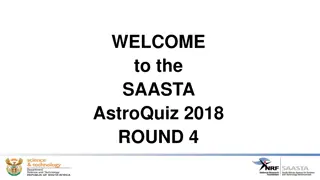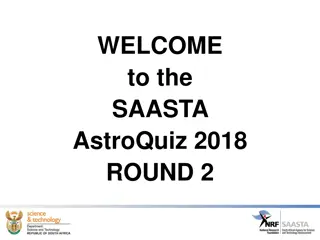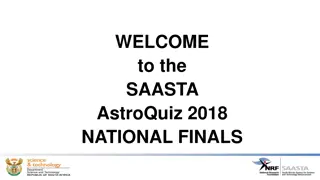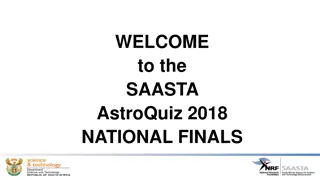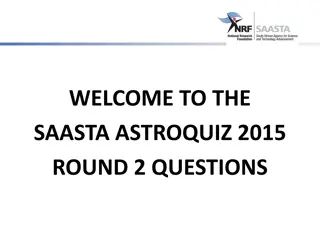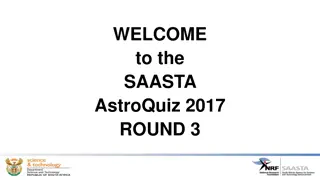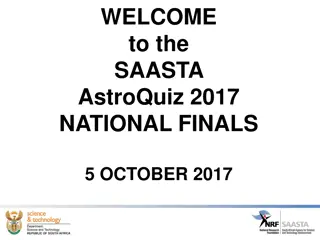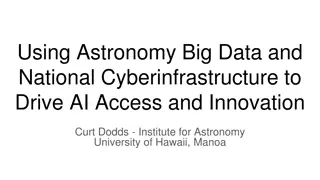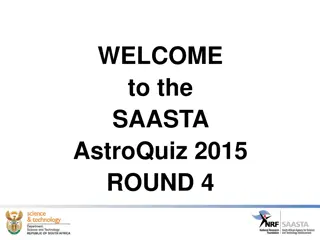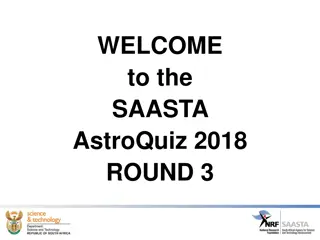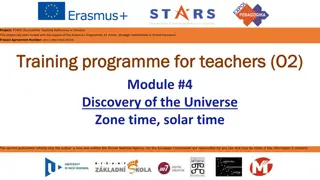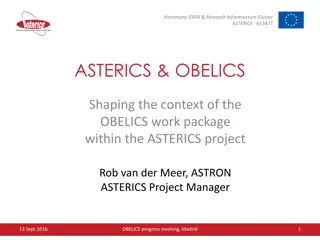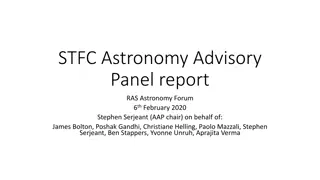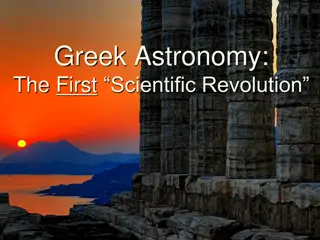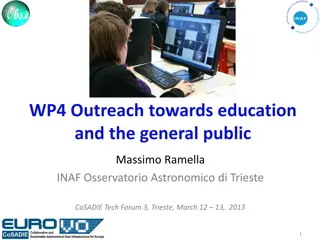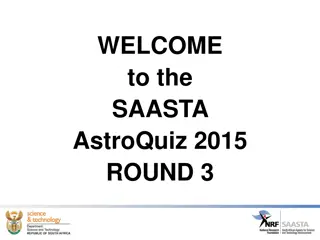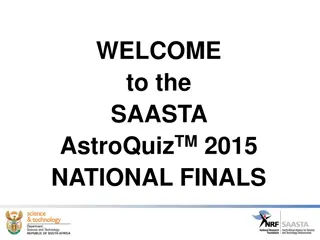SAASTA AstroQuiz 2017 Round 4: Challenge Your Astronomy Knowledge!
Welcome to the SAASTA AstroQuiz 2017 Round 4! Engage in a timed quiz where you must answer a series of questions related to astronomy within 60 seconds. Explore diagrams and information about celestial bodies like the Earth, Moon, and Sun. Test your knowledge on eclipses, shadows, and telescopes. Get ready to participate as a team and showcase your astronomical expertise!
Download Presentation

Please find below an Image/Link to download the presentation.
The content on the website is provided AS IS for your information and personal use only. It may not be sold, licensed, or shared on other websites without obtaining consent from the author.If you encounter any issues during the download, it is possible that the publisher has removed the file from their server.
You are allowed to download the files provided on this website for personal or commercial use, subject to the condition that they are used lawfully. All files are the property of their respective owners.
The content on the website is provided AS IS for your information and personal use only. It may not be sold, licensed, or shared on other websites without obtaining consent from the author.
E N D
Presentation Transcript
WELCOME to the SAASTA AstroQuiz 2017 ROUND 4
RULES You only have 60 seconds to answer the questions. You are allowed to discuss amongst yourselves as team members. Calculators may be used if needed. No internet is to be used, therefore the use of cellphones is also prohibited. The judge s decision is final.
DIAGRAM 1: The next 5 questions refer to this image.
MORE INFORMATION Diameter of the Moon = 3 475 km Diameter of the Earth = 12 756 km Diameter of the Sun = 1 391 000 km Circumference of the Sun = 4 366 813 km Volume of the Sun is 1.4 x 1027m3 Volume of the Earth = 1.1 x 1021m3 Volume of the Moon = 2.2 x 1019m3
QUESTION 1 This diagram shows ____ A. The entire Solar System B. An Eclipse C. A comet passing the Earth D. The daily relationship between the Earth, Moon and Sun
QUESTION 2 What type of eclipse does this diagram show? A. Lunar Eclipse B. Transit Eclipse C. Solar Eclipse D. Galaxy Eclipse
QUESTION 3 The sequence C on Diagram 1, relates to the larger diagram. It shows _______ as seen from the Earth? A. A dark spot on the Sun B. The transition of the Moon across the Sun C. The phases of the Moon D. The phases of the Sun
QUESTION 4 The full shadow cast by the Moon onto the Earth in the diagram A is called______ A. The Shadow B. The Umbra C. The Penumbra D. The Full Point
QUESTION 5 The partial shadow cast by the Moon onto the Earth in the diagram (B) is called: A. The Secondary Shadow B. The Umbra C. The Penumbra D. The Partial Point
QUESTION 6 South Africa's MeerKAT telescope is an SKA 'pathfinder' telescope. How many dish-shaped antennas will it consist of? A. 64 B. 74 C. 46 D. 47
QUESTION 7 The third closest star to Earth after the Sun is at a distance of approximately 4,37 light years. If 1 light year = 9,46 x 1012km, how far is it in kilometres? 2.16 x 1012 4.62 x 1010 5.09 x 1012 4.13 x 1013 A. B. C. D.
QUESTION 8 If the Earth has a radius of 6378 kilometres, what will its circumference be in kilometres? NB: C = 2 r , = 3.14 A. 4.01 x 104 B. 4.001 x 105 C. 4.001 x 106 D. 40.1 x 107
QUESTION 9 The brightest star in the sky, Sirius, is/was __ A. closest to the Earth B. whiter and hotter than the Sun C. blue and hot D. discovered by Robert Innes in 1915
QUESTION 10 During total lunar eclipse ______ A. The Sun is behind Earth, so the Sun's light casts Earth's shadow on the Moon. B. Moon is between the Earth & the Sun C. The Sun is between the Earth & Moon D. The Earth is behind the Sun so that sunlight hits the Moon directly
QUESTION 11 What is a loose collection of ice, dust, and small rocky particles, typically with a long, narrow orbit called? A. Comet B. Asteroid C. Meteor D. Meteorite
QUESTION 12 What gives Mars its reddish colour? A. Sunlight B. Iron Oxide C. Glass D. Water
QUESTION 13 Who developed the three laws describing the motion of planets? A. Tycho Brahe B. Albert Einstein C. Johannes Kepler D. Daniel Young
QUESTION 14 Albert Einstein is most famous for his Theory of __ A. Relationships B. Archaeology C. Philosophy D. Relativity
QUESTION 15 For a solar eclipse to occur, ____ A. the Sun must be directly between Earth and the Moon B. the Moon must be directly between Earth and the Sun C. the Moon must be directly behind Earth D. Earth must be directly between the Sun and the Moon
QUESTION 16 In 1993, the European communications satellite Olympus was hit by a ____ and the mission had to be cancelled. A. Meteor B. Meteorite C. Meteoroid D. Constellation
QUESTION 17 Jupiter's Great Red Spot is a giant ______ A. storm B. crater C. ocean D. volcano
QUESTION 18 What do we call the part of the Sun that is most easily seen during a total solar eclipse? A. Solar wind B. Heliosphere C. Corona D. Hemisphere
QUESTION 19 Where do we find most asteroids in our solar system? A. Between Mars and Earth B. Between Mars and Jupiter C. Between Mars and Saturn D. Between Mars and Pluto
QUESTION 20 Which type of telescope never has problems seeing through Earth's atmosphere and can use mirrors or lenses to enlarge an object. A. Earth-based telescope B. Reflecting telescope C. Refracting telescope D. Space-based telescope
QUESTION 21 The brightest star in the night sky is Sirius. What is the name of the second brightest star? A. Acturus B. Canopus C. Rigel D. Betelgeuse
QUESTION 22 The Southern Cross, Crux, is the smallest constellation whilst ____ is the largest in the sky. A. Cancer B. Scorpio C. Hydra D. Orion
QUESTION 23 One of the principal objectives of the New Horizons Mission was to give a better understanding of Pluto and its moons. A. True B. False
QUESTION 24 When was New Horizons launched into space? A. 14 June 2016 B. 19 January 2006 C. 14 July 2015 D. 28 February 2007
QUESTION 25 When did this spacecraft, New Horizons, fly by Pluto? A. 14 June 2016 B. 19 January 2006 C. 14 July 2015 D. 28 February 2007
QUESTION 26 When did this spacecraft, New Horizons, fly by Jupiter? A. 14 June 2016 B. 19 January 2006 C. 14 July 2015 D. 28 February 2007
QUESTION 27 What is name of the brightest star in the constellation of Orion? A. B. C. D. Betelgeuse Antares Rigel Bellatrix
QUESTION 28 Which star s 100thanniversary, since its discovery, was celebrated in 2015? A. The Sun B. Alpha Centauri C. Sirius D. Proxima Centauri
QUESTION 29 Who made the discovery of this star and from where was the discovery made? A. Caroline Shoemaker; USA Observatory B. Robert Innes; SAASTA Johannesburg Observatory C. Johannes Kepler; Germany Observatory D. Sivuyile Manxoyi; South African Astronomical Observatory
QUESTION 30 There was a solar eclipse on 21 August 2017 but sadly it was not visible in South Africa at all. A. True B. False
THANK YOU FOR PARTICIPATING
